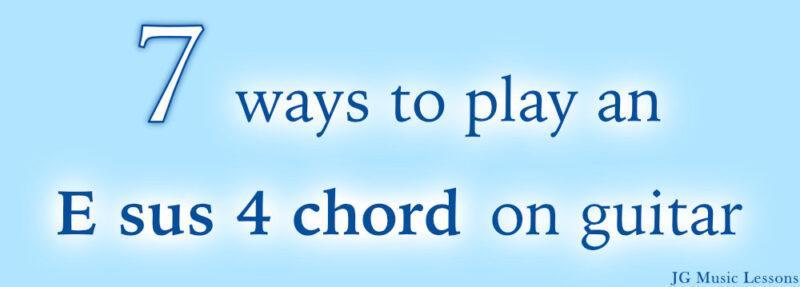After learning your open chords on the guitar, you’ll soon want to know how to play sus 4 chords, which often come up in many popular songs. In this lesson, we’ll be covering the E sus 4 chord, which is short for suspended 4.
The E sus 4 chord has an easy open chord shape but there are many different ways you can play this chord throughout the guitar fretboard. By knowing different E sus 4 chord variations, you’ll be able to use them in different musical contexts.
We’ll first cover some basic chord theory and then show you 7 ways to play an E sus 4 chord which you can start to incorporate to your playing.
Let’s get started.
E sus 4 chord theory intro
A suspended 4 chord means that the 4th degree replaces the 3rd of the chord. For example, a Major triad chord has the chord tones 1, 3, and 5 but a sus 4 chord has chord tones 1, 4, and 5.
This means that an E sus 4 chord has the chord tones E, A, and B.
Here is the formula for sus 4 chords below.
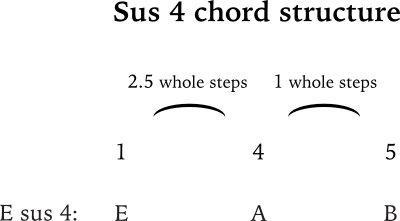
To compare, here are the notes for other chords with E as the root.
- E Major chord has the chord tones E, G#, and B.
- E minor chord has the chord tones E, G, and B.
Now that you know what notes belong to the chord structure, let’s look at how to read the chord charts.
How to read the chord charts
For the charts below:
- The top horizontal line of the chord chart represents the high E string and the bottom horizontal line represents the low E string.
- The vertical lines separate each fret.
- The numbers in the blue dots tell you which fingers to use on the fretting hand.
- The letters on the right of the charts tell you what notes you are playing on each string.
- Circles on the left represent open strings.
- Red X means to avoid that string.
You can check this link for more on how to read guitar notation symbols.
Easy E sus 4 chord
An easy way to play an E sus 4 chord is to play the 2nd fret on the 4th and 3rd string like this:
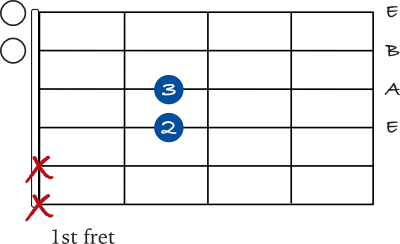
Open E sus 4 chord
This is the most common way to play an E sus 4 chord. This chord is very similar to an open E Major chord, except your pinky is on the 3rd string, 2nd fret.
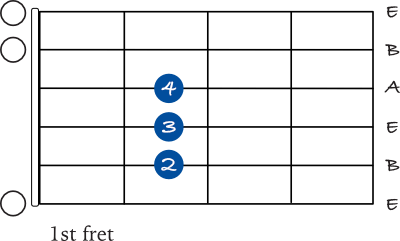
E sus 4 chord – 4th fret
Here is an E sus 4 chord in the middle area of the fretboard, also using an open 6th string. This shape is more suitable for a fingerpicking style of playing because some strings are avoided.
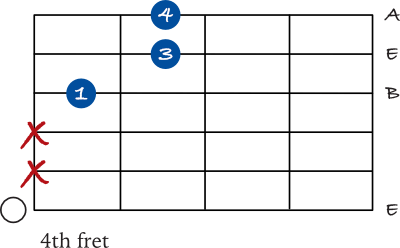
E sus 4 chord – 7th fret
Here is another E sus 4 chord on the 7th fret that is also ideal for a fingerpicking style because of the string skipping.
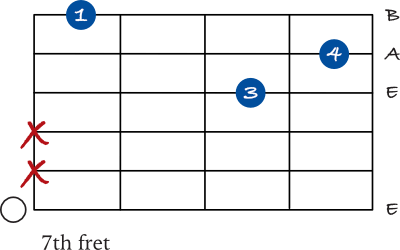
E sus 4 barre chord on the 5th string
This is the barre chord version of the last chord which comes from the open A sus 4 chord shape. If you can’t get the chord to sound clear, first try to get the notes from the 5th to the 2nd fret. As you develop more strength in your fingers, try adding the 1st string as well.
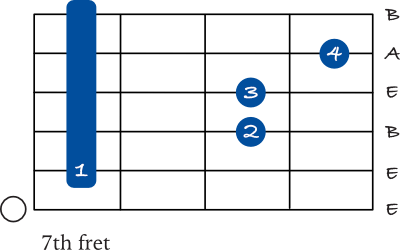
If needed, check out these 5 tips to get better at playing barre chords.

E sus 4 barre chord – 5th string variation
Another way to play the E sus 4 chord using a barre is to remove the 2nd finger from the previous shape.
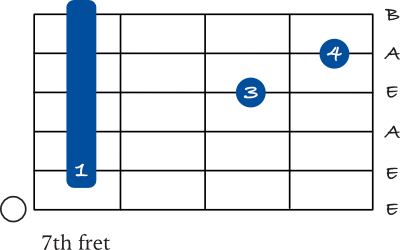
Compare this chord variation with the previous shape to hear the slight difference and see which one you like better.
E sus 4 barre chord on the 4th string
This is the only chord where the E note is not in the bass, meaning the lowest note. The shape comes from the easy open G sus 4 chord. This is another way you can play this chord when you want the root note highlighted at the top.

Wrapping up
It’s good to know different variations of playing a sus 4 chord because you have more flexibility to move around the fretboard and also when you need a specific note in the top to help define a melody that you are playing over.
I hope this helped you understand how to play a E sus4 guitar chord or learn new ways of playing it. You can also try shifting the shapes that have all fretted notes to play other sus 4 chords on the same string.
📘 Get the free guitar practice guide here!
All the best,
JG Music Lessons
Start Playing Better, Faster
with Pro Membership! ✨
Get the guidance, tools, and support that keep your progress on track:
🏁 Always know what to practice next. Access the full Guitar Learning Roadmap with lessons in sequence.
🎼 Play songs with confidence. Step-by-step lessons of popular, classical pieces and other styles.
📙 Save time and frustration. Clear PDFs and ebooks that save time so you can focus on playing.
🎟️ Get rewarded for consistency. 2 free downloads every month (a $240+ yearly value).
🎁 Keep costs low while you grow. 50% off all charts, tracks, and posters — up to 75% off bundles.
🚫 Stay focused. Ad-free environment keeps you in the zone.
💬 Get help when you need it. Direct member support to keep you on track.

